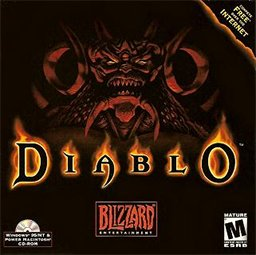Diablo

Cover art from Diablo.
Set in the fictional Kingdom of Khanduras (located in the Diablo series fantasy world of Sanctuary), Diablo has the player take control of a lone hero as he or she battles to rid the world of the eponymous Lord of Terror. Beneath the town of Tristram, the player journeys through sixteen dungeon levels to ultimately come face to face with Diablo and his demon minions.
An expansion pack, entitled Diablo: Hellfire, was released in 1997, although it was not created by Blizzard Entertainment. This was followed by a true sequel, Diablo II, in 2000, and a third game, Diablo III, was announced on June 28, 2008 at Blizzard's World Wide Invitational in Paris, France.
Story
The story of Diablo is based on the premise of a war between Heaven and Hell. The town of Tristram has come under attack by demons, and the player must save the town and, in effect, the world, by ridding it of the Lord of Terror. As the player delves into the underworld, some of the history behind the war between Heaven and Hell, as well as knowledge about Diablo himself, are revealed through large tomes that are found throughout the levels.
Diablo is the Lord of Terror and one of the Three Prime Evils of Hell, the most powerful lords of demonkind. Long before the events of the game, he was captured by a secretive order of mortal magi known as the Horadrim. The Horadrim imprisoned each of the Prime Evils in a Soulstone; Diablo's red stone was buried in caverns deep beneath the town of Tristram, and as the generations passed, was forgotten. Though his imprisonment was meant to be eternal, the power of the Soulstone weakened over centuries, eventually allowing Diablo to use limited power from within the stone. He telepathically turned an inhabitant of Tristram, the Archbishop Lazarus, into his pawn. In order for Diablo to actually leave the Soulstone, Diablo needed to possess a host. Through his minion Lazarus, he initially tried to gain control of King Leoric, the local ruler, but Diablo, in his weakened state, was unable to overpower Leoric. Abandoning the idea, he caused Lazarus to kidnap King Leoric's son, Prince Albrecht. He inspired such terror in the child that the boundaries between the realms were broken and parts of Hell appeared in the mortal world, taking root in the labyrinth beneath Tristram. Diablo then chose to bide his time and wait for the opportune moment to strike.
Soon afterwards King Leoric was driven to madness by the loss of his son. With Lazarus whispering in his ear, he ordered a foolhardy attack on a far stronger neighboring realm - a campaign to which Lazarus made sure to send all of the King's most loyal and good-hearted heroes. The campaign proved a suicide mission, and soon the King had only the lies of Lazarus for counsel. Leoric began brutally executing the subjects he once protected, suspecting everyone of the kidnapping of his son. Lazarus led groups of townsfolk into the labyrinth in supposed pursuit of the missing prince - but Lazarus's only purpose was to deliver the innocents up to death at the hands of the demons. At length, the few survivors of the army returned home, led by the noble Sir Lachdanan. Leoric immediately ordered their execution, and, seeing the King for the tortured soul he was, Lachdanan killed his King with a mercy stroke. Upon his dying breath, Leoric cursed those who were close to him that they should serve him in the underworld for all of eternity, creating the horrific undead knights of the labyrinth.
Shortly after, the time period of the game begins as the player's character arrives. He or she has to fight their way through sixteen levels to face Diablo, encountering various monsters and quests to challenge them. The labyrinth descends from a simple dungeon to dark caves and catacombs and finally the fiery pits of Hell. The player finds a portal to Archbishop Lazarus' lair, slays him, and makes his way to Diablo. At the end of the game, the player character has killed Diablo's mortal form, and left Diablo once more with just a soulstone to inhabit. Now in hopes of retaining the Lord of Terror, the hero pierces his or her head with the soulstone, attempting to contain the Lord of Terror within his or herself. This was exactly what Diablo had planned all along, as the hero would be a much better host than the prince. Diablo II later confirms that Diablo indeed possessed the hero who slew him.
| Allakhazam credits this article at Wikipedia for some of the info in this article. Licensed under the GFDL. |
|
